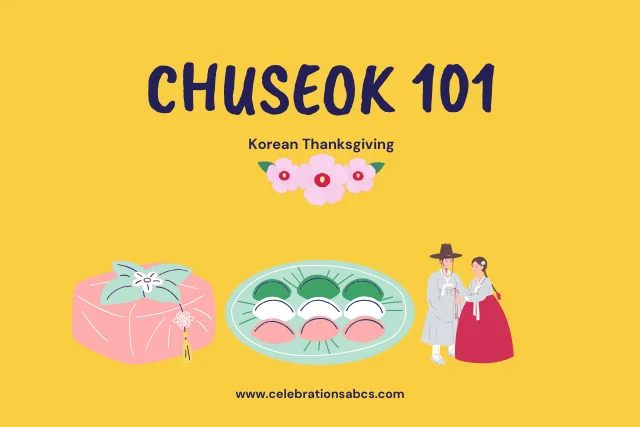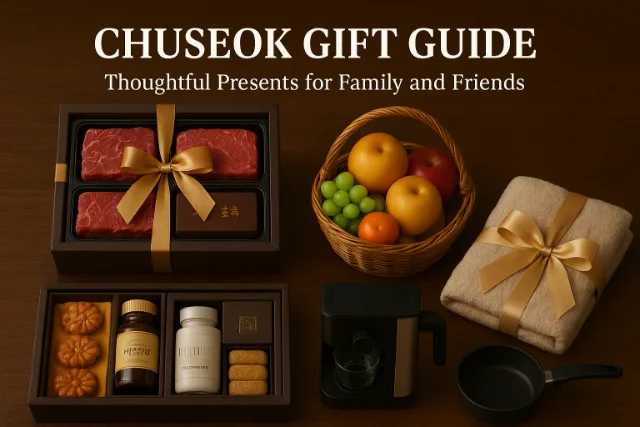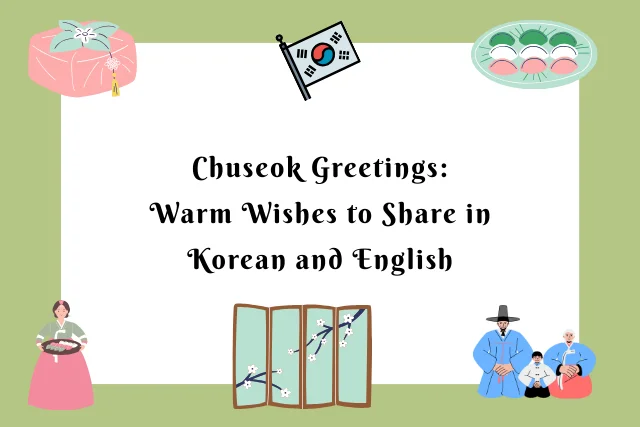As an Amazon Associate, I earn from qualifying purchases. This post may contain affiliate links. If you make a purchase through these links, we may earn a commission at no additional cost to you. Please read our full disclosure here.
Close your eyes and imagine a holiday that combines the heartfelt family gathering of Thanksgiving, the respectful remembrance of Memorial Day, and the joyful, abundant feasting of a harvest festival. Now, open them and allow us to introduce you to Chuseok (추석).
Often called Korean Thanksgiving, Chuseok is so much more than a simple day off on the calendar. It is the heartbeat of Korea’s autumn, a deeply cherished time when the entire nation pauses to give thanks, honor its roots, and gather with those who matter most. If you’ve ever been curious about this beautiful celebration, you’ve come to the right place. Consider this your essential guide to understanding the meaning, traditions, and delicious flavors of Korea’s biggest holiday.
When is Chuseok? (Mark Your Calendars!)
Chuseok follows the lunar calendar, falling on the 15th day of the 8th lunar month – which means its date on the Gregorian calendar changes each year. In 2025, the main day of Chuseok is Friday, October 6th.
The holiday is officially observed for three days: the day before, the day of, and the day after Chuseok. This creates the 2025 holiday period of October 5th (Sunday) through October 7th (Tuesday).
This three-day window triggers one of the world’s largest annual human migrations as millions of Koreans travel to their hometowns. The days leading up to Chuseok are famous for massive traffic jams on highways and fully-booked transportation systems. If you’re planning to be in Korea during this time or celebrate with Korean friends, it’s wise to mark these dates early and plan accordingly.
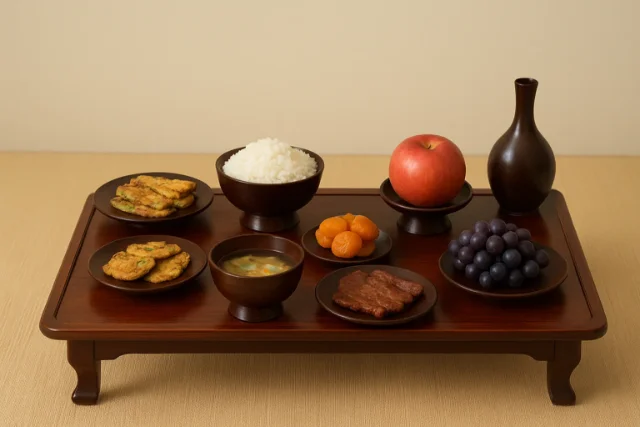
The Heart of Chuseok: Key Traditions and Their Meanings
Chuseok comes alive through traditions that beautifully blend solemn respect with joyful family connection.
The celebration begins with the great journey home (Gwiseong-gil), where millions return to their ancestral hometowns, creating one of Korea’s most notable annual travel periods.
Once families are reunited, several meaningful rituals take place:
Beolcho and Seongmyo: Families visit ancestral graves to clear weeds (Beolcho) and pay respects with offerings (Seongmyo)
Charye: An elaborate ancestral memorial ceremony held at home, where a table is meticulously set with special foods and family members perform deep bows
Sebae: The younger generation performs a deep traditional bow to their elders, receiving blessings and often Sebaetdon (monetary gifts) in return
These customs form the emotional core of Chuseok, connecting generations through shared rituals of remembrance and respect.
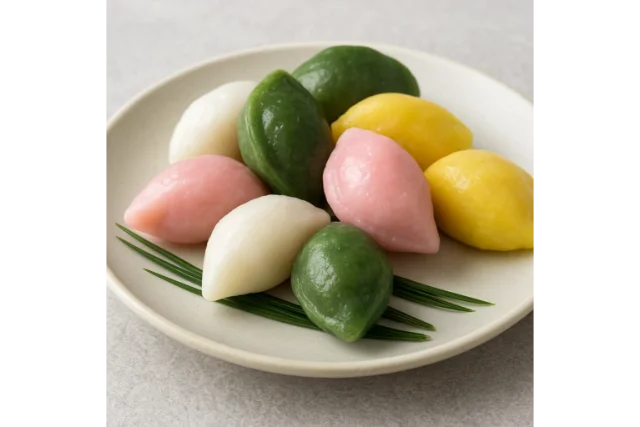
The Feast: A Taste of Chuseok
At the heart of Chuseok is a feast that symbolizes gratitude and the year’s harvest. The preparation is a family ritual, with generations gathering in the kitchen.
The most iconic food is songpyeon (송편). These small, half-moon-shaped rice cakes are more than just a treat; their shape symbolizes a bright and prosperous future. The dough is often colored naturally with ingredients like mugwort (green) or pumpkin (yellow), and they are filled with sweet sesame or red bean paste. The act of making them together is a cherished part of the holiday.
The Festive Banchan: A Table of Abundance
Surrounding the songpyeon is a lavish spread of dishes that showcase the season’s best ingredients. Each dish carries its own meaning of prosperity and thanksgiving.
Jeon (전): An assortment of savory, pan-fried pancakes made with ingredients like zucchini, mushrooms, fish, or kimchi. Jeon represents the overall bounty of the harvest and is a staple of festive occasions.
Japchae (잡채): Stir-fried glass noodles made from sweet potato, mixed with colorful vegetables and beef. Its long, unbroken noodles symbolize wishes for a long life and prosperity.
Galbi Jjim (갈비찜) or Meat Dishes: Braised short ribs or other premium meats are served to signify celebration and wealth, highlighting the importance of the feast.
Fruits: The autumn harvest brings forth a beautiful display of fruits like crisp Bae (Korean pears), Danggeun (persimmons), and Janghowon Melons, which are often artfully arranged and exchanged as prized gifts.
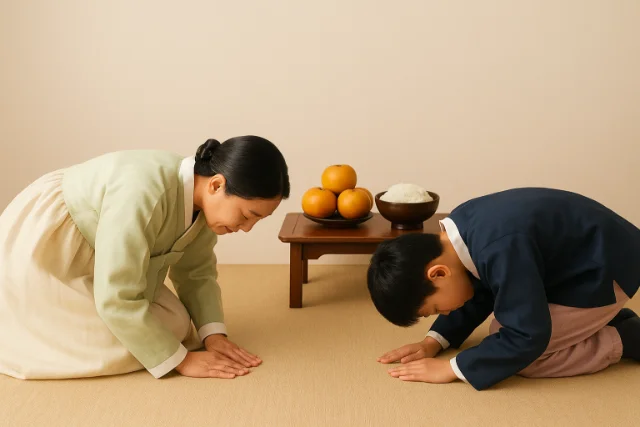
The Art of Gift-Giving During Chuseok
Gift-giving is a central and highly anticipated part of Chuseok, serving as a tangible expression of respect and gratitude toward family, friends, and business associates. This tradition extends the holiday’s spirit of generosity beyond the family dinner table.
The most common gifts are beautifully packaged gift sets (선물세트), available in department stores and markets weeks before the holiday. Popular choices include:
Practical Essentials: High-quality cooking oil, Spam, and tuna sets remain classic favorites, valued for their everyday usefulness.
Premium Treats: Gift boxes of hanwoo (Korean beef), fresh fruit, high-grade rice, or traditional sweets are seen as luxurious indulgences.
Health and Wellness: Packages containing red ginseng, vitamins, and health supplements reflect a wish for the recipient’s well-being.
Within families, the tradition of sebaetdon (세뱃돈) “money given to elders after performing the traditional bow (sebae)” is still widely practiced, often presented in elegant envelopes.
While this culture of gift-giving is a generous display of respect, it also sparks annual conversations about the financial pressure and commercialization of the holiday. Despite this, the act remains a deeply ingrained and meaningful way to strengthen social bonds and show appreciation during this important time.
The Spirit of Gratitude
At its heart, Chuseok remains a powerful celebration of family, heritage, and gratitude. While traditions like making songpyeon and paying respects to ancestors form its foundation, the holiday continues to evolve with modern life.
Whether celebrated through a large family gathering, a quiet meal, or a “Friendseok” with chosen family, the essence remains the same: taking time to honor our roots and cherish our connections. It’s this timeless spirit of thankfulness that makes Chuseok such an enduring and beloved celebration.
추석 잘 보내세요! (Happy Chuseok!)
